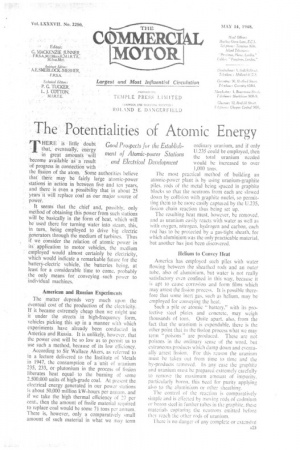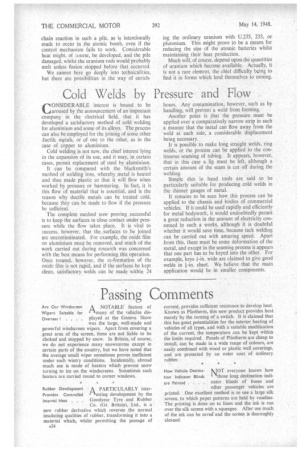The P.ptatialities of Atomic Energy HERE is little doubt that,.
Page 25

Page 26

If you've noticed an error in this article please click here to report it so we can fix it.
eventually; enerky in great amounts will 'become available asa result df progress in connection with the fission of the atom. Some authorities believe that there may be fairly large atomic-power Stationg, in 'actiOn in betWeen five and ten years, and there is even a Possibility that in about 25 years it Will replace coal as our major source of power.
It seems that the chief and, possibly, only method of obtaining this power 'from such stations will be basically in the form of heat, which will be 'used there for turning Water into steam, this, in turn, being employed, to drive big electric generators through the medium of turbines. Thus if we eonsider the relation of atomic power in its application to motor vehicles, the medium employed would almost certainly be electricity, which would indicate a remarkable future for the battery-electric vehicle, the batteries being, at least for a considerable time to come, probably the only means for:' conveying such power to individual machines.
American and Russian Experiments The matter depends very much upon the eventual etast of the Production of the electricitY. If it.becarne extremely cheap then we might Use it under the .streets .in high-frequency form, vehicles picking this, up in a manner with which experiments, have already been conducted in America and RusSia. • It is unlikely, however that the, power cost will be so low as to permit us to use such amethod-, because of its low efficiency.
According to, 'Sir Wallace Akers, as referred to in a lecture delivered to the Institute of Metals in 1947, the conSumption of a -unit of uranium 235, 233, or -plutonium in the process of fission liberates heat equal to the burning of some 2.500.000 units of high-grade coal. At present the electrical energy .generated in our power stations is about 50,000 million kW-hours per annum, and if we take the high thermal efficiency of 27 per cent:, then the amount of fissile material required to replace coal would he some 73tons per annum. There is, however, only a comparati‘ely small amount of such material in what we may term ordinary uranium, and if only U.235 could be employed, then the total uranium needed Development would be increased to over 1,000 tons.
The most practical method of building an atomic-power plant is by using uranium-graphite piles, rods of the metal being spaced in graphite blocks so that the neutrons from each are slowed down by collision with graphite nuclei, so permitting them to be more easily captui al by the U.235, fission chain reaction thus being set up.
The resulting heat must, however, he removed, and as uranium easily reacts with water as well as vith oxygen, nitrogen, hydrogen and carbon. each rod has to be protected by a gas-tight sheath, for which aluminium was the only practicable material, but another has just been discovered.
Helium to Convey Heat America has employed such piles with water flowing between the sheathed rods and an outer tube, also of aluminium, but water is not really satisfactory even confined in this way, because it is apt to cause corrosion and formfilms which may arrest the fission process. It is possible therefore that some inert gas, such as helium, may be employed for conveying, the heat.
Such a pile or atomic " battery," with its protective steel plates and concrete, may weigh thousands of tons. Quite apart, also, from the fact that the uranium is expendable, there is the other point that in the fission process what we may term " poisons " are produced. These are not poisons in the ordinary sense of the word, hut extraneous products Nxhich damp down and eventually arrest fission. For this reason the uranium must be taken out from time to time and the by-products removed. In any case the graphite and uranium must be prepared extremely carefully to remove. the in amount of impurity. particularly boron, this need for purity applying also to the aluminium or other sheathing.
The control of the reaction is comparatively simple and is effected by moving rods of cadmium or boron steel in further tubes in the graphite, these materials capturing the neutrons emitted before they reach the other rods of uranium.
There is no danger of any complete or extensive A23 chain reaction in such a pile, as is intentionally made to occur in the atomic bomb, even if the control mechanism fails to work. Considerable heat might, of course, be developed, and the pile damaged, whilst the uranium rods would probably melt unless fission stopped before that occurred. We cannot here go deeply into technicalities, but there are possibilities in the way of enrich ing the ordinary uranium with U.235, 233, or plutonium. This might prove to be a means for reducing the size of the• atomic batteries whilst maintaining their heat production.
Much will, of course, depend upon. the quantities of uranium which become available. Actually, it is not a rare element, the chief difficulty being to find it in forms which lend themselves to mining.




















































































